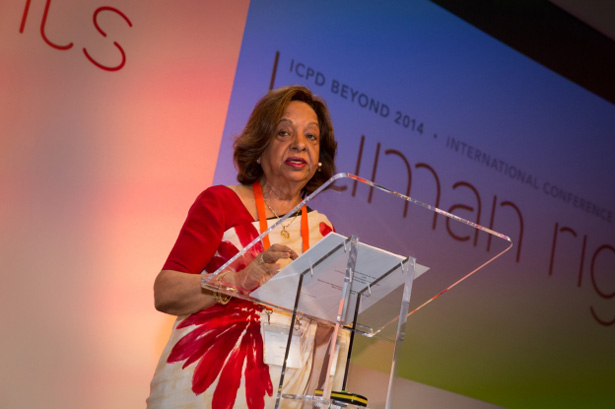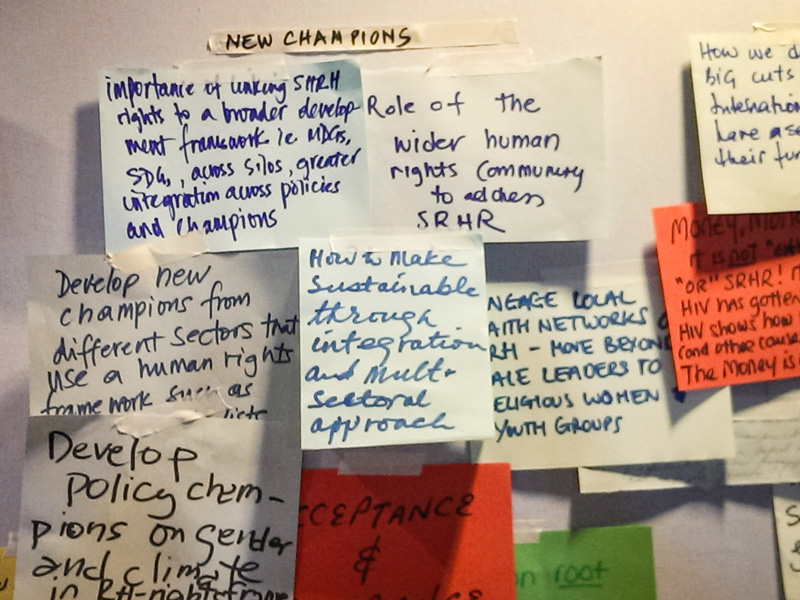-
On World Population Day, ICPD Conference Reminds Us of Population’s Role in Development
July 11, 2013 By Roger-Mark De Souza
“The development agenda is discretionary and the human rights agenda is obligatory,” said Kitty van der Heijden, the ambassador for sustainable development in the Dutch Ministry of Foreign Affairs, on the final day of the ICPD International Conference on Human Rights here in the Netherlands.
Van der Heijden touched on what I think is a central tension on World Population Day, here at this conference, and in the concept of sustainable development in general: How does a human rights framework, with its obligatory and accountability components, dovetail with efforts to advance development priorities – such as reproductive health – that improve people’s lives but many consider discretionary?
Organized by the Government of the Netherlands, the United Nations Population Fund (UNFPA), and the Office of the United Nations High Commissioner for Human Rights, the ICPD conference brought together more than 300 government and civil society representatives from more than 135 countries with UN representatives, experts, and human rights defenders to identify key achievements, barriers, and emerging challenges to delivering the goals of the first International Conference on Population and Development (ICPD), famously held in Cairo in 1994.
Decision-Makers, Not Pawns
The central challenge in talking about population and sex in international development is the specter of “population control” programs, which were unfortunately deployed in some places during the mid-20th century. One of the core goals of the 1994 ICPD was to establish, once and for all, a broad international agreement that the incorporation of population into development agendas should be rights-based, not control-based.
“To follow the Cairo agenda is to respect and promote human rights,” said Dr. Nafis Sadik, the former executive director of UNFPA, in her keynote opening address here:
When we talk about “reproductive rights,” this is what we mean. It’s the difference between people as objects and people as agents; between regarding people as pawns on the policy chessboard and recognizing them as the players, the decision-makers, the drivers of policy – autonomous individuals intimately concerned with the direction of their own lives.
As the host of a panel here on population dynamics, I saw how the different delegates approach this issue, and I can say that it’s still a challenge for some. For example, during our discussion on key elements to ensure that population policies respect, protect, and fulfill human rights, a government representative from a Southeast Asian country asked me, “How can I convince poor indigenous women of the benefits of having fewer children in a way that does not violate their human rights?”
That’s clear violation of the Cairo agenda, as reiterated so eloquently by Sadik. Fortunately, the vast majority of conference delegates I spoke to affirm that the Cairo agenda today is part of the obligation to respect and promote human rights. We know that investments in girls’ education and voluntary family planning and reproductive health services – which let women decide when and how many children to have – are successful development strategies with many positive impacts.
Can PHE Be a Model?
 So what does “rights + development,” as the slogan of the conference puts it, look like in this context?
So what does “rights + development,” as the slogan of the conference puts it, look like in this context?On the “ideas billboard” – an open area where delegates could add thoughts on key priorities for the conference – some delegates noted the possibility of integrating population, reproductive health, and environmental approaches. Population, health, and environment (PHE) projects, many of which we’ve profiled at the Wilson Center, do just that, linking immediate community goals (e.g., family health, sanitation, food security, livelihoods) and forward-thinking sustainable development goals (e.g., biodiversity preservation, reduced deforestation, climate change adaptation, relieving land and food pressure).
But one of the most powerful advantages of successful PHE projects is the community trust they engender. By meeting self-identified community needs across sectors, these projects are far more sustainable than many single-sector development interventions. This approach is at the heart of a human rights-based approach to development, and I think provides a model for others looking to link the “discretionary” elements of development and the “obligatory” components found in the concepts of right to health, right to life, and right to development.
Celebrating New Voices
Perhaps one of the most inspiring components of the conference – and a reason for us to celebrate World Population Day today – was the bright and engaged participation of youth.
The young people at the conference affirmed their position on the importance of addressing rights, reproductive health, and youth leadership, articulated last year at the Bali Global Youth Forum. This is a time of unprecedented youth engagement in the development dialogue. As Paulini Turagabeci, a youth activist from Fiji, noted, “it’s not just for seasoned engagers…ICPD is not an exclusive club for its pioneers.” I wholeheartedly agree and celebrate the youth commitment to, and engagement in, human rights, development, and respectful and responsible sexual and reproductive rights for all.
Ultimately, as the chair of the final panel at the conference said, we are all young; we’re just in different stages of youth. Today, let’s celebrate the vision of the Cairo agenda, recognize the value of a human rights framework, and join in the leadership of less seasoned, but fully competent, engagers who are moving the sustainable development agenda forward.
Sources: IPCD.
Photo Credit: Former UNFPA Executive Director Dr. Nafis Sadik speaking at the ICPD International Conference on Human Rights, courtesy of ICPD/UNFPA; Big ideas board courtesy of Roger-Mark De Souza/Wilson Center.
Topics: Asia, climate change, development, education, environment, family planning, featured, food security, gender, global health, humanitarian, land, livelihoods, PHE, population, poverty, sanitation, UN, youth
 A Publication of the Stimson Center.
A Publication of the Stimson Center.




